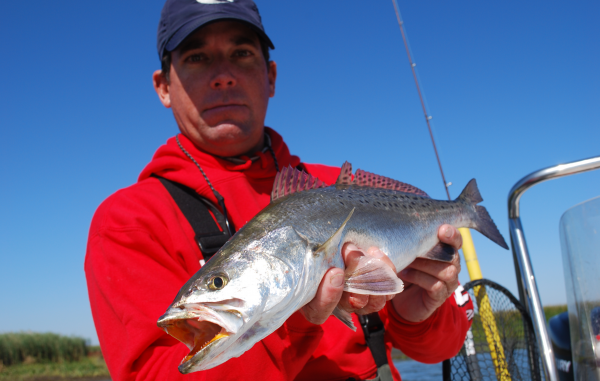
Capt. Nash Roberts IV talks speckled trout fishing on both sides of the Mississippi River out of Port Sulphur
In this excerpt from Trout Masters Too: How the pros do it, Capt. Nash Roberts IV with Fishhunter Guide Service shares his thoughts on rods, reels and the line he uses to catch big speckled trout.
“Trout are one of the best-eating fish. And when you are on them, you can catch a bunch. They are aggressive and will take topwater baits. They are more of a challenge than redfish — so susceptible to the weather. The weather is everything on trout. You can have the best tide in the world, but if it’s blowing 20 miles an hour, trout fishing is tough.
“When you get the right conditions, it’s heaven. It’s rarer to get great conditions for trout than redfish. Trout have people’s attention because they are good to eat and we have liberal limits.
“I think that I’ve become a speckled trout specialist over the years. At least half my customers want to catch nice speckled trout — 15 inches and up. Personally, I don’t consider a trout a trophy until it is over 5 pounds.”
But the father-and-son duo have learned to adjust to their customers’ needs and are versatile. They do a lot of shallow-water sight-fishing for redfish with customers, both fly fishermen and hardware chuckers. Roberts enjoys shallow-water fishing in particular. He admits, “I love to watch fish eat.”
As could be expected of a man with his largemouth bass-fishing background, Roberts uses mainly casting reels — Shimano Chronarchs or Curados. “They last, they are smooth, they have good drag systems,” he explains. “Baitcasting is just a personal preference of mine. I’ve been using them since I was a kid. I don’t really think that there is any advantage in using a baitcasting reel.”
His rods are almost all Shimanos, 7 feet long and medium or medium-light in action. He likes a limber tip. “They are easier to cast and don’t rip the hook out of the fish’s mouths,” he says. “I want the lightest, most sensitive rod I can get — something that won’t wear me out fishing all day.” That means higher-end rods costing $150 to $250 being the norm.
His druthers on line when fishing speckled trout is for Trilene Big Game monofilament in 12- or 15-pound test. He prefers mono because he feels that it casts better. It also has stretch and doesn’t rip the hook out of a trout’s mouth. “At least that’s my theory,” he says with a grin.
When he does use a spinning reel, however, it is always spooled with PowerPro 30-pound-test braided line. The same goes for when he is targeting redfish and bass instead of specks. When he uses braided line for fishing plastics, he rigs up with a 20- to 30-pound monofilament leader that is 14 to 18 inches long. When he fishes with a cork, he uses a similar length above and below the cork. “Braided line twists like crazy,” he says.
He doesn’t use fluorocarbon because he feels that water here seldom gets clear enough to need it and the fish in Louisiana are not as pressured as in some other areas.
Learn more about how the best guides and anglers across the Louisiana coast catch trout day in, day out by purchasing the Trout Masters Tool Kit, which includes a special package price for Trout Masters: How Louisiana’s Best Anglers Catch the Lunkers and Trout Masters Too: How the pros do it.


